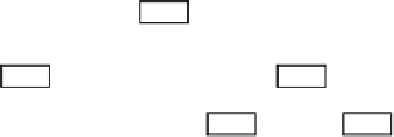Java Reference
In-Depth Information
This is a special kind of binary tree. It has the property that, given
any
node, a word in the left subtree is “smaller,”
and a word in the right subtree is “greater” than the word at the node. (Here,
smaller
and
greater
refer to alphabetical
order.)
Such a tree is called a
binary search tree
(BST). It facilitates the search for a given key using a method of searching
similar to the binary search of an array.
Consider the search for
ria
. Starting at the root,
ria
is compared with
ode
. Since
ria
is greater (in alphabetical
order) than
ode
, we can conclude that if it is in the tree, it must be in the right subtree. It must be so since all the nodes
in the left subtree are smaller than
ode
.
Following the right subtree of
ode
, we next compare
ria
with
tee
. Since
ria
is smaller than
tee
, we follow the left
subtree of
tee
. We then compare
ria
with
ria
, and the search ends successfully.
But what if we were searching for
fun
?
1.
fun
is smaller than
ode
, so we go left.
2.
fun
is smaller than
lea
, so we go left again.
3.
fun
is greater than
era
, so we must go right.
But since the right subtree of
era
is empty, we can conclude that
fun
is not in the tree. If it is necessary to add
fun
to the tree, note that we have also found the place where it must be added. It must be added as the right subtree of
era
,
as shown in Figure
8-4
.
ode
lea
tee
era
mac
ria
vim
fun
Figure 8-4.
BST after adding fun
Thus, not only does the binary search tree facilitate searching, but if an item is not found, it can be easily inserted.
It combines the speed advantage of a binary search with the easy insertion of a linked list.
The tree drawn in Figure
8-3
is the optimal binary search tree for the seven given words. This means that it is the
best possible tree for these words in the sense that no shallower binary tree can be built from these words. It gives the
same number of comparisons to find a key as a binary search on a linear array containing these words.
But this is not the only possible search tree for these words. Suppose the words came in one at a time, and as each
word came in, it was added to the tree in such a way that the tree remained a binary search tree. The final tree built
will depend on the order in which the words came in. For example, suppose the words came in this order:
mac tee ode era ria lea vim
Initially the tree is empty. When
mac
comes in, it becomes the root of the tree.
tee
comes next and is compared with
mac
. Since
tee
is greater, it is inserted as the right
subtree of
mac
.
•
ode
comes next and is greater than
mac
, so we go right;
ode
is smaller than tee, so it inserted as
the left subtree of
tee
.
•
era
is next and is smaller than
mac
, so it is inserted as the left subtree of
mac
.
•




Search WWH ::

Custom Search